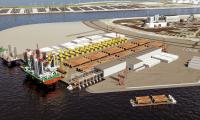
Port of rotterdam becomes the fifth partner
The North Sea Wind Power Hub Consortium welcomes a strong partner with a clear sustainability strategy. Experience by Port of Rotterdam in seaward land reclamation (Maasvlakte 2) will be a valuable asset for the consortium.
Towards a more sustainable industry
Allard Castelein, CEO, Port of Rotterdam: “Industry needs sustainable electricity and hydrogen if it is to meet the climate change targets of the Paris Agreement. The concept of a North Sea Wind Power Hub is an appealing prospect for the development of a large-scale, sustainable energy system in the North Sea. We are experienced in seaward land reclamation, and we are happy to contribute this expertise to the consortium. We really need to speed up efforts to develop large-scale offshore wind energy capacity, and ensure this capacity is effectively integrated into the relevant plans of the North Sea countries.”
The four electricity and gas grid companies and the Port of Rotterdam will join forces for the purpose of continuing their studies into the development of a large-scale, sustainable European energy system in the North Sea. The collaboration is important for the development of a North Sea Wind Power Hub from 2030 onward, which will make a major contribution towards achieving the objectives of the Paris climate change agreement.
The EU’s climate change objectives will require a significant development of offshore wind energy capacity in the North Sea. The deployment estimates range from 70 GW to 150 GW of offshore wind in the North Sea in 2040. A specific scenario conducted by the consortium which is based on the COP21 Paris Agreement commitment estimates 180 GW offshore wind capacity by 2045 in the North Sea.
Making industry more sustainable is a major issue for Europe. According to calculations commissioned by the Port of Rotterdam, enabling the sustainable operation of Rotterdam’s industry alone would require between 27 and 49 TWh of generation capacity. Volumes in that order of magnitude can only be achieved by offshore wind energy. Assuming 4,000 operating hours per year for offshore wind turbines, 27 to 49 TWh would require between 7 and 12 GW of installed capacity, equivalent to roughly 1,000 10 MW wind turbines. Right now, the most powerful wind turbines have a capacity of 6 MW.
To date, 1 GW of wind power capacity has been installed in the Dutch sector of the North Sea. Taking into account the offshore wind farm zones currently designated and earmarked (Borssele, Holland Coast), by 2023 this capacity will have been expanded by 3.5 GW. In other words, current plans fall far short of the requirement of Rotterdam’s industry.
Hubs in the central North Sea
The consortium’s vision starts from a stepwise development with bi-national hybrid connections and builds towards an accelerated roll-out facilitated by large scale (10-30 GW) offshore wind collection hubs feeding and connecting multiple North Sea countries. The consortium wants to make the European climate and energy objectives feasible as well as affordable.
Central to this vision is the construction of one or more hubs with interconnections to the countries bordering the North Sea. These artificial islands/hubs will need to be situated in the North Sea, at a site offering ideal wind conditions, i.e. frequent high wind speeds. For far-offshore wind farm sites, a coordinated international approach with an island-based solution will be 30% more cost-effective than the ‘business-as-usual’ connection model with HVDC converter platforms on individual jackets.
A hub will be able to accommodate a large number of links to wind turbines and/or off-shore wind farms, and facilitate the distribution and transmission of wind-generated elec-tricity via direct-current connections to the North Sea countries (the Netherlands, Belgium, the United Kingdom, Norway, Germany and Denmark).
These connections – so-called ‘Wind Connectors’ – will not only transmit wind power from the wind farms to the hub/island, but will simultaneously serve as interconnectors between the energy markets of the aforementioned countries, enabling them to trade electricity across their borders.
On a hub, wind power can also be converted to sustainable hydrogen for large-scale transport to shore or for storage or buffering purposes. Hydrogen is currently produced from natural gas with carbon as a by-product. Combining the strengths of electricity and gas supply systems may also provide a boost to the use of hydrogen as a sustainable solu-tion in numerous applications in industry, transportation, and the built environment.
Power-to-gas conversion is expected to play an important part in the further analyses of the North Sea Wind Power Hub system. It could enable wind-generated energy to be converted into gaseous form close to its sources (i.e. far offshore), and then brought ashore possibly using the existing offshore gas infrastructure.
In a nutshell, an island could fulfil the following purposes:
- Cost-effective alternative for large offshore converter platforms
- Work island for wind farm developers and maintenance activities
- Hub for collecting alternating current from surrounding wind farms and intercon-necting the surrounding countries using high-capacity direct-current ‘electricity highways’
- Converting electricity to gas (such as hydrogen)
